Outlook for Direct Use of Sunflower and Castor Oils as Biofuels in Compression Ignition Diesel Engines, Being Part of Diesel/Ethyl Acetate/Straight Vegetable Oil Triple Blends
Abstract
1. Introduction
2. Materials and Methods
2.1. Ethyl Acetate/Vegetable Oil Double Blends and Diesel/Ethyl Acetate/Vegetable Oil Triple Blends
2.2. Characterization of the (Bio)fuel Blends
2.2.1. Kinematic Viscosity
2.2.2. Pour Point (PP) and Cloud Point (CP)
2.2.3. Calorific Value
2.2.4. Cetane Number
2.3. Performance of a Diesel Engine-Electrogenerator Set Fuelled with EA/SVO and D/EA/SVO Blends
3. Results and Discussion
3.1. Fuel Properties of EA/SVO Double Blends, and D/EA/SVO Triple Blends
3.2. Performance of a Diesel Engine Operating as Electric Generator
3.3. Smoke Emissions: Opacity
3.4. Fuel Consumption
4. Conclusions
- All investigated blends comply with requirements of kinematic viscosity (2.0−4.5 cSt) established by the European diesel standard EN 590, for usage in current diesel engines. However, calorific value and cetane number were reduced by the incorporation of ethyl acetate.
- The addition of ethyl acetate led to remarkable improvements in flow properties of fuels at low temperatures in comparison to conventional diesel, which makes these fuels more suitable for engine running in colder climates.
- Excellent results of power output were achieved with the B20–B60 D/EA/SO and with the B20–B80 D/EA/CO blends. The best performance was shown by fuels composed of castor oil, especially the B20 and B40 mixtures, exhibiting even better results than diesel at high engine load (4000 and 5000 W).
- The consumption of engine fueled with the studied blends was greater than with conventional diesel due to low calorific value of ethyl acetate.
- The high oxygen content of ethyl acetate was the key factor to enhance the combustion process and to achieve a very notable reduction of soot emissions. Higher proportion of EA/SVO in mixtures decrease the opacity generated by the engine. Hence, the mixtures B100 provided the better behaviour in term of achieving lower emissions.
- This study also reveals that the EA/SVO double blends can be employed as direct biofuels without adding fossil diesel, making these fuels completely renewable.
- The best results were achieved over the B40 blend with CO, which generated similar or even higher power output than diesel at the highest engine load values, with lower soot emissions and very similar fuel consumption. Moreover, this blend exhibited the best CP and PP values. With the B40 blend, a 60% of fossil diesel substitution was achieved. Furthermore, the production of ethyl acetate through renewable process like acidogenic fermentation from low-value biomass, constitutes a fundamental tool towards more sustainable production of alternative fuels for transportation sector.
- Finally, the multi-component blending is a promising strategy to attain higher percentages of fossil fuel substitution, at the same time that exhaust emissions from the transportation sector are significantly diminished, keeping very good engine performance. This initial experimental study represents an advance in the search for new biofuels that can replace the fossil fuels used in the present fleet of vehicles.
Author Contributions
Funding
Acknowledgments
Conflicts of Interest
Nomenclature
| ACE | Acetone |
| ASTM | American society for testing and materials |
| B0 | 100% diesel |
| B20 | 80% diesel + 20% EA/SVO blend |
| B40 | 60% diesel + 40% EA/SVO blend |
| B60 | 40% diesel + 60% EA/SVO blend |
| B80 | 20% diesel + 80% EA/SVO blend |
| B100 | 100% EA/SVO blend |
| BTE | Brake thermal efficiency |
| BSFC | Brake specific fuel consumption |
| CI | Compression ignition |
| CN | Cetane number |
| CO | Castor oil |
| CP | Cloud point |
| cSt | Centistokes |
| CV | Calorific value |
| D | Diesel |
| DEE | Diethyl ether |
| ISO | International Standards Organization |
| LVLC | Lower viscosity and lower calorific value |
| LVS | Low viscosity solvent |
| PP | Pour point |
| rpm | Round per minute (min−1) |
| SO | Sunflower oil |
| SVO | Straight vegetable oil |
| VO | Vegetable oil |
| W | Watts |
| Symbols | |
| A | Amperage (amps) |
| C | Calibration constant (mm2/s)/s |
| P | Electrical power (watts) |
| t | Flow time (s) |
| V | Voltage (volts) |
| υ | Viscosity (centistokes) |
References
- Alalwana, H.A.; Alminshid, A.H.; Aljaafaric, H.A.S. Promising evolution of biofuel generations. Subject review. Renew. Energy Focus 2019, 28, 127–139. [Google Scholar] [CrossRef]
- Rodionova, M.V.; Poudyal, R.S.; Tiwari, I.; Voloshin, R.A.; Zharmukhamedov, S.K.; Nam, H.G.; Zayadan, B.K.; Bruce, B.D.; Hou, H.J.M.; Allakhverdiev, S.I. Biofuel production: Challenges and opportunities. Review article. Int. J. Hydrogen Energy 2017, 42, 8450–8461. [Google Scholar] [CrossRef]
- Estevez, R.; Aguado-Deblas, L.; Bautista, F.M.; Luna, D.; Luna, C.; Calero, J.; Posadillo, A.; Romero, A.A. Biodiesel at the Crossroads: A critical review. Catalysts 2019, 9, 1033. [Google Scholar] [CrossRef]
- Luque, R.; Herrero-Davila, L.; Campelo, J.M.; Clark, J.H.; Hidalgo, J.M.; Luna, D.; Marinas, J.M.; Romero, A.A. Biofuels: A technological perspective. Energy Environ. Sci. 2008, 1, 542–564. [Google Scholar] [CrossRef]
- Sivalakshmi, S.; Balusamy, T. Performance and emission characteristics of a diesel engine fueled by neem oil blended with alcohols. Int. J. Ambient Energy 2011, 32, 170–178. [Google Scholar] [CrossRef]
- Hurtado, B.; Posadillo, A.; Luna, D.; Bautista, F.; Hidalgo, J.; Luna, C.; Calero, J.; Romero, A.; Estevez, R. Synthesis, performance and emission quality assessment of ecodiesel from castor oil in diesel/biofuel/alcohol triple blends in a diesel engine. Catalysts 2019, 9, 40. [Google Scholar] [CrossRef]
- Rakopoulos, D.C. Combustion and emissions of cottonseed oil and its bio-diesel in blends with either n butanol or diethyl ether in HSDI diesel engine. Fuel 2013, 105, 603–613. [Google Scholar] [CrossRef]
- Kumar, N.; Bansal, S.; Pali, H.S. Blending of Higher Alcohols with Vegetable Oil-Based Fuels for Use in Compression Ignition Engine; SAE Technical Paper 2015-01-0958; SAE International: Warrendale, PA, USA, 2015. [Google Scholar]
- Kasiraman, G.; Nagalingam, B.; Balakrishnan, M. Performance, emission and combustion improvements in a direct injection diesel engine using cashew nut shell oil as fuel with camphor oil blending. Energy 2012, 47, 116–124. [Google Scholar] [CrossRef]
- Kommana, S.; Naik Banoth, B.; Radha Kadavakollu, K. Eucalyptus-Palm kernel oil blends: A complete elimination of diesel in a 4-stroke VCR diesel engine. J. Combust. 2015, 2015, 182879–182886. [Google Scholar] [CrossRef]
- Prakash, T.; Geo, V.E.; Martin, L.J.; Nagalingam, B. Evaluation of pine oil blending to improve the combustion of high viscous (castor oil) biofuel compared to castor oil biodiesel in a CI engine. Heat Mass Transf. 2019, 55, 1491–1501. [Google Scholar] [CrossRef]
- Martin, M.L.J.; Geo, V.E.; Singh, D.K.J.; Nagalingam, B. A comparative analysis of different methods to improve the performance of cotton seed oil fuelled diesel engine. Fuel 2012, 102, 372–378. [Google Scholar] [CrossRef]
- Vallinayagam, R.; Vedharaj, S.; Yang, W.; Roberts, W.L.; Dibble, R.W. Feasibility of using less viscous and lower cetane (LVLC) fuels in a diesel engine: A review. Renew. Sustain. Energy Rev. 2015, 51, 1166–1190. [Google Scholar] [CrossRef]
- Lakshminarayanan, A.; Olsen, D.B.; Cabot, P.E. Performance and emission evaluation of triglyceride-gasoline blends in agricultural compression ignition engines. Appl. Eng. Agric. 2014, 30, 523–534. [Google Scholar]
- Estevez, R.; Aguado-Deblas, L.; Posadillo, A.; Hurtado, B.; Bautista, F.; Hidalgo, J.M.; Luna, C.; Calero, J.; Romero, A.; Luna, D. Performance and emission quality assessment in a diesel engine of straight castor and sunflower vegetable oils, in diesel/gasoline/oil triple blends. Energies 2019, 12, 2181. [Google Scholar] [CrossRef]
- Aguado-Deblas, L.; Hidalgo-Carrillo, J.; Bautista, F.; Luna, D.; Luna, C.; Calero, J.; Posadillo, A.; Romero, A.; Estevez, R. Diethyl ether as an oxygenated additive for fossil diesel/vegetable oil blends: Evaluation of performance and emission quality of triple blends on a diesel engine. Energies 2020, 13, 1542. [Google Scholar] [CrossRef]
- Aguado-Deblas, L.; Hidalgo-Carrillo, J.; Bautista, F.; Luna, D.; Luna, C.; Calero, J.; Posadillo, A.; Romero, A.; Estevez, R. Acetone prospect as an additive to allow the use of castor and sunflower oils as drop-in biofuels in diesel/acetone/vegetable oil triple blends for application in diesel engines. Molecules 2020, 25, 2935. [Google Scholar] [CrossRef]
- Kumar, A.; Rajan, K.; Kumar, K.R.S.; Maiyappan, K.; Rasheed, U.T. Green fuel utilization for diesel engine, combustion and emission analysis fuelled with CNSO diesel blends with Diethyl ether as additive. Mater. Sci. Eng. 2017, 197, 1–10. [Google Scholar] [CrossRef]
- Krishnamoorthi, M.; Malayalamurthi, R. Availability analysis, performance, combustion and emission behavior of Bael Oil—Diesel—Diethyl ether blends in a variable compression ratio diesel engine. Renew. Energy 2018, 119, 235–252. [Google Scholar] [CrossRef]
- Gurav, H.; Bokade, V.V. Synthesis of ethyl acetate by esterification of acetic acid with ethanol over a heteropolyacid on montmorillonite K10. J. Nat. Gas Chem. 2010, 19, 161–164. [Google Scholar] [CrossRef]
- Sato, A.G.; Biancolli, A.L.G.; Paganin, V.-A.; da Silva, G.C.; Cruz, G.; dos Santos, A.M.; Ticianelli, E.A. Potential applications of the hydrogen and the high energy biofuel blend produced by ethanol dehydrogenation on a Cu/ZrO2 catalyst. Int. J. Hydrogen Energy 2015, 40, 14716–14722. [Google Scholar] [CrossRef]
- Contino, F.; Foucher, F.; Mounaïm-Rousselle, C.; Jeanmart, H. Experimental characterization of Ethyl acetate, Ethyl propionate, and Ethyl butanoate in a homogeneous charge compression ignition engine. Energy Fuels 2011, 25, 998–1003. [Google Scholar] [CrossRef]
- Jones, R. Ethyl Acetate as Fuel or Fuel Additive. U.S. Patent Application No. 12,792,867, 8 December 2011. [Google Scholar]
- Gangwar, J.N.; Saraswati, S.; Agarwal, S. Performance and emission improvement analysis of CI engine using various additive based diesel fuel. In Proceedings of the International Conference on Advances in Mechanical, Industrial, Automation and Management Systems (AMIAMS), Allahabad, Uttar Pradesh, India, 3–5 February 2017; pp. 189–195. [Google Scholar]
- Wu, S.; Yang, H.; Hu, J.; Shen, D.; Zhang, H.; Xiao, R. The miscibility of hydrogenated bio-oil with diesel and its applicability test in diesel engine: A surrogate (ethylene glycol) study. Fuel Process. Technol. 2017, 161, 162–168. [Google Scholar] [CrossRef]
- Zhang, L.; Shen, C.; Liu, R. GC–MS and FT-IR analysis of the bio-oil with addition of ethyl acetate during storage. Front. Energy Res. 2014, 2, 3. [Google Scholar] [CrossRef]
- Çakmak, A.; Kapusuz, M.; Özcan, H. Experimental research on ethyl acetate as novel oxygenated fuel in the spark-ignition (SI) engine. In Energy Sources, Part A: Recovery, Utilization, and Environmental Effects; Taylor & Francis: Abingdon, UK, 2020. [Google Scholar]
- Ashok, M.P. Study of the performance and emissions of the compression-ignition (CI) engine using ethyl acetate as a surfactant in ethanol-based emulsified fuel. Energy Fuels 2010, 24, 1822–1828. [Google Scholar] [CrossRef]
- Ramadhas, A.S.; Jayaraj, S.; Muraleedharan, C. Biodiesel production from high FFA rubber seed oil. Fuel 2005, 84, 335–340. [Google Scholar] [CrossRef]
- Keera, S.T.; El Sabagh, S.M.; Taman, A.R. Castor oil biodiesel production and optimization. Egpt. J. Petrol. 2018, 27, 979–984. [Google Scholar] [CrossRef]
- Shahir, S.A.; Masjuki, H.H.; Kalam, M.A.; Imran, A.; Fattah, I.M.R.; Sanjid, A. Feasibility of diesel–biodiesel–ethanol/bioethanol blend as existing CI engine fuel: An assessment of properties, material compatibility, safety and combustion. Renew. Sustain. Energy Rev. 2014, 32, 379–395. [Google Scholar] [CrossRef]
- Dwivedi, G.; Sharma, M.P. Impact of cold flow properties of biodiesel on engine performance. Renew. Sustain. Energy Rev. 2014, 31, 650–656. [Google Scholar] [CrossRef]
- Krishnamoorthi, M.; Malayalamurthi, R. Experimental investigation on performance, emission behavior and exergy analysis of a variable compression ratio engine fueled with diesel-aegle marmelos oil-diethyl ether blends. Energy 2017, 128, 312–328. [Google Scholar] [CrossRef]
- Labeckas, G.; Slavinskas, S.; Kanapkiene, I. The individual effects of cetane number, oxygen content or fuel properties on the ignition delay, combustion characteristics, and cyclic variation of a turbocharged CRDI diesel engine—Part 1. Energy Convers. Manag. 2017, 148, 1003–1027. [Google Scholar] [CrossRef]
- Hellier, P.; Ladommatos, N.; Allan, R.; Payne, M.; Rogerson, J. The impact of saturated and unsaturated fuel molecules on diesel combustion and exhaust emissions. SAE Int. J. Fuels Lubr. 2012, 5, 106–122. [Google Scholar] [CrossRef]
- Sendzikiene, E.; Makareviciene, V.; Janulis, P. Influence of composition of fatty acid methyl esters on smoke opacity and amount of polycyclic aromatic hydrocarbons in engine emissions. Pol. J. Environ. Stud. 2007, 16, 259–265. [Google Scholar]

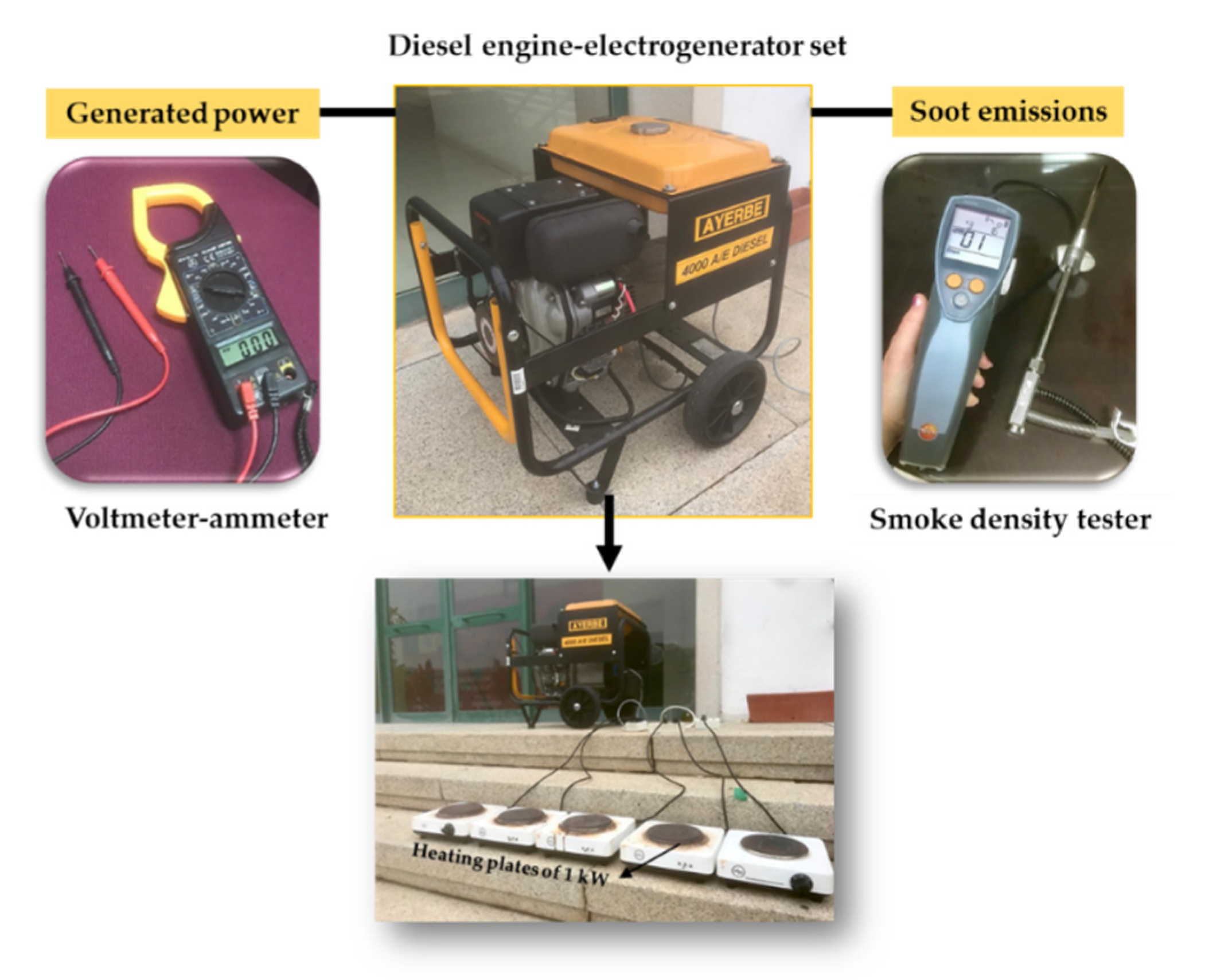
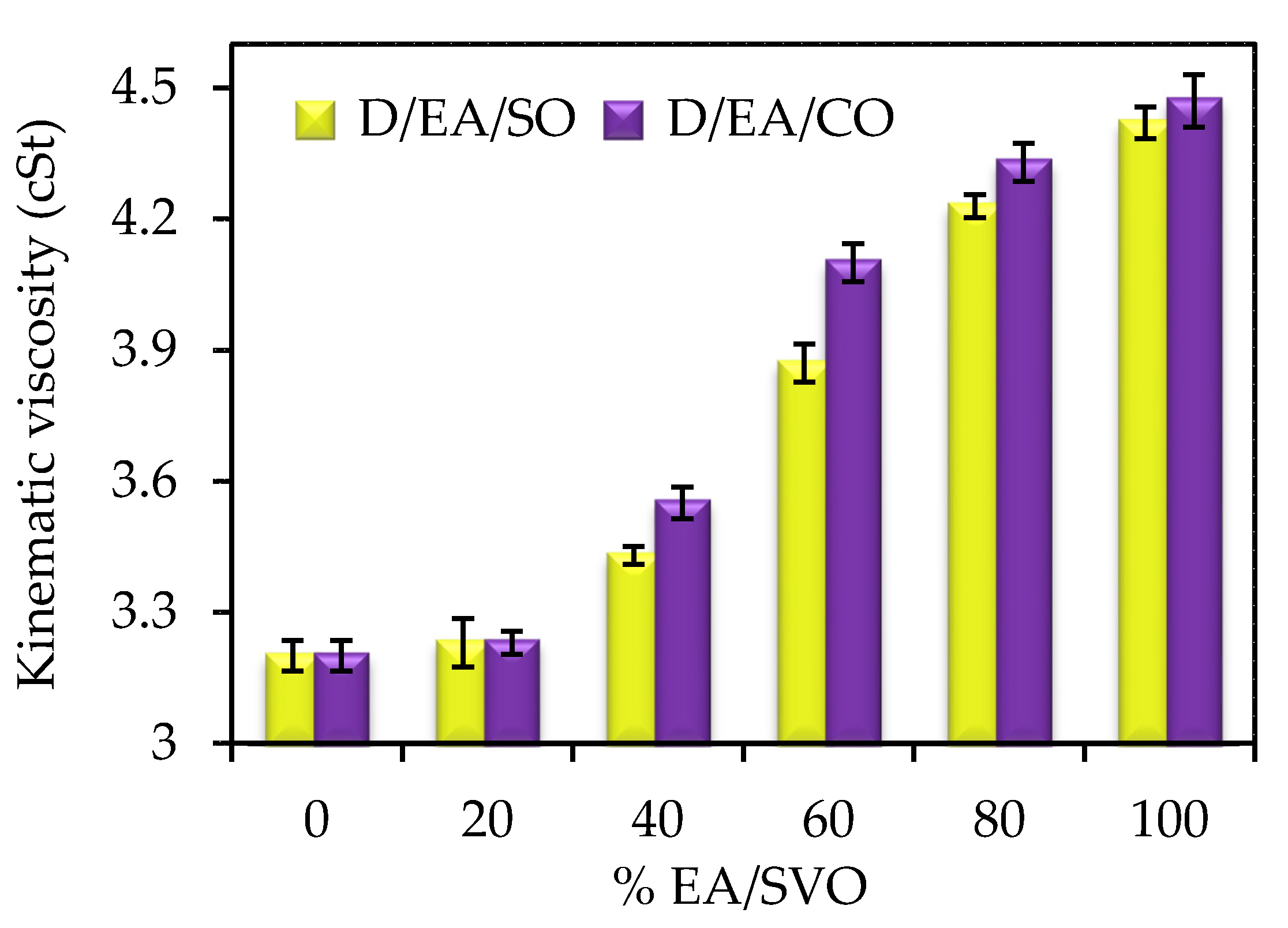
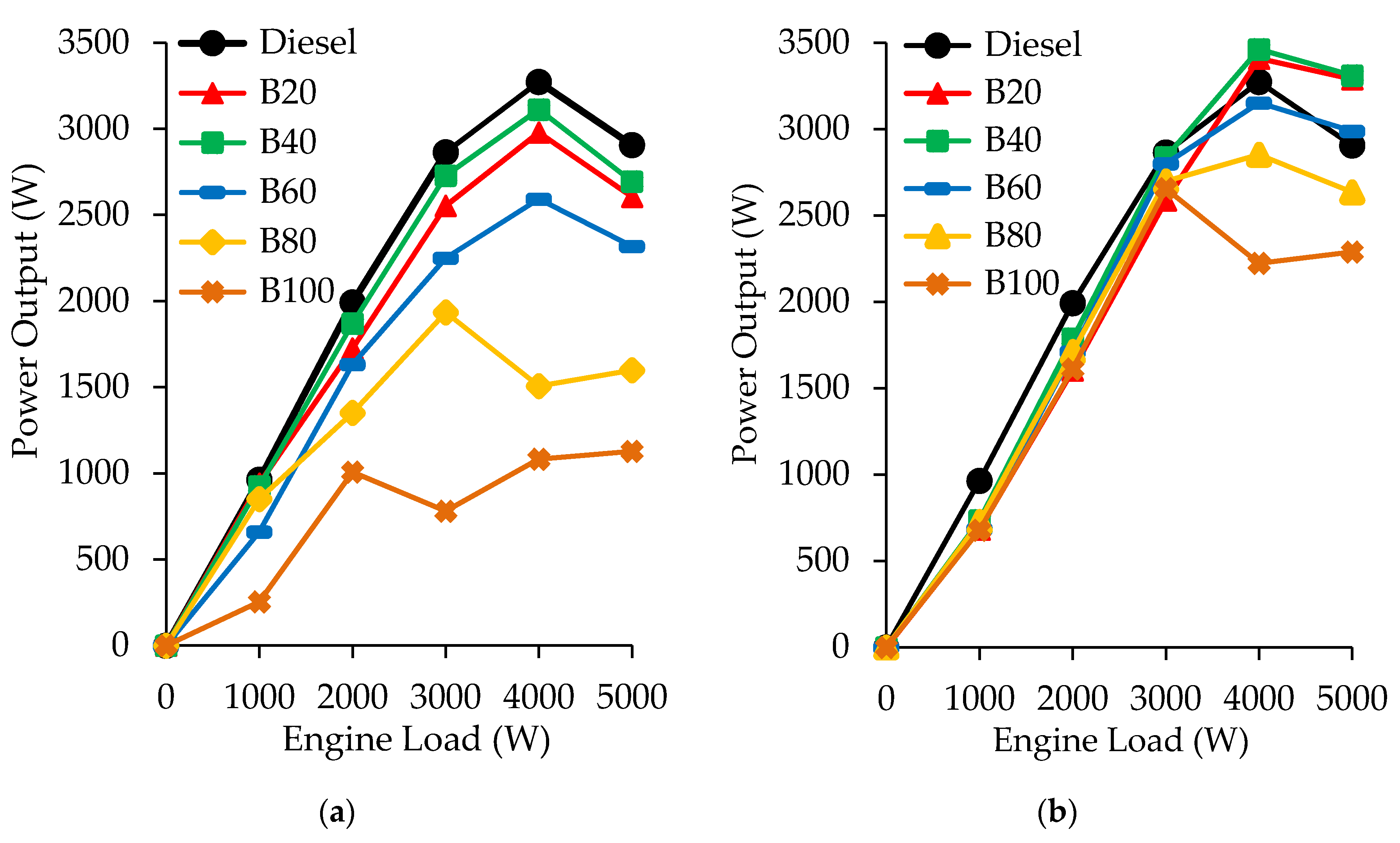
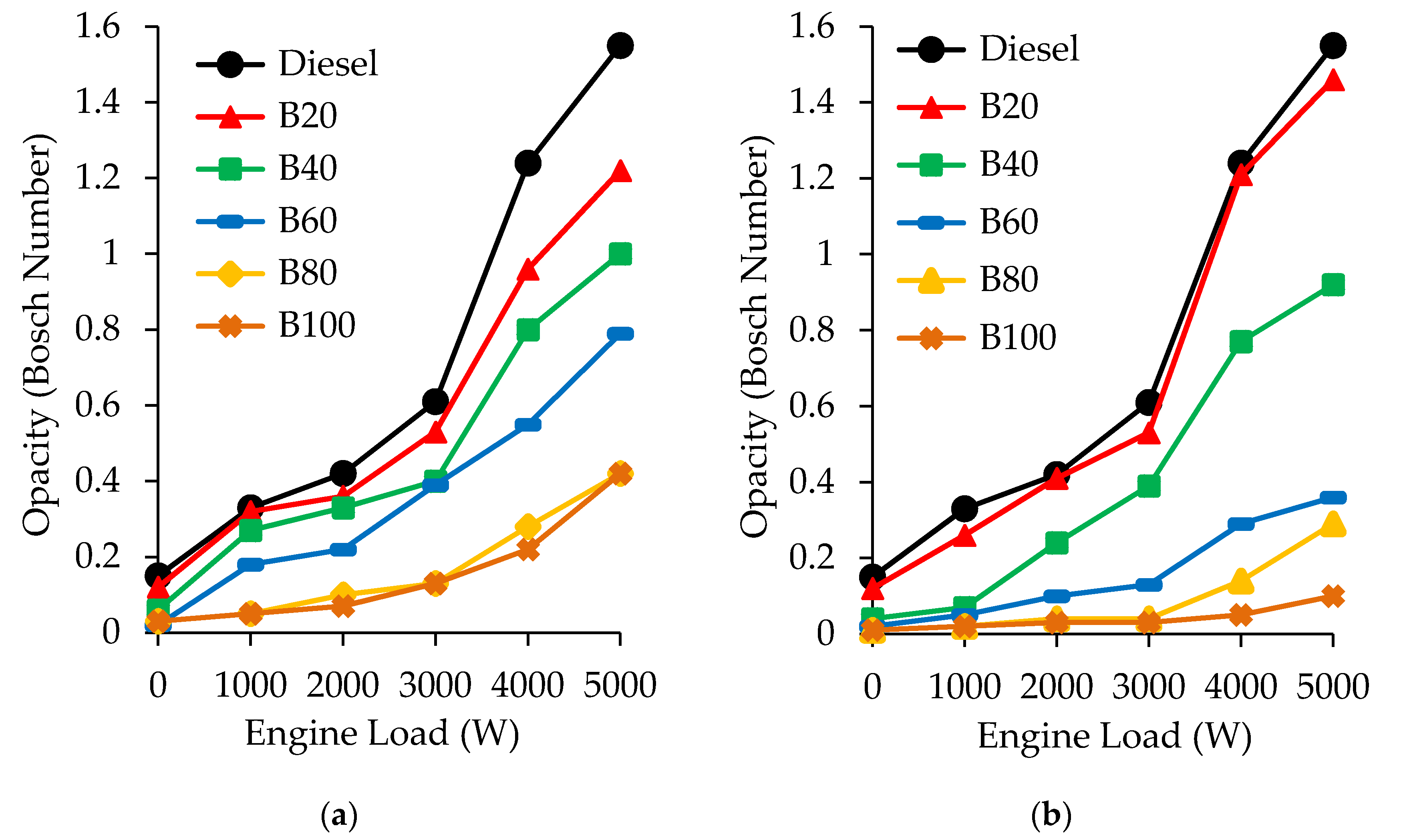
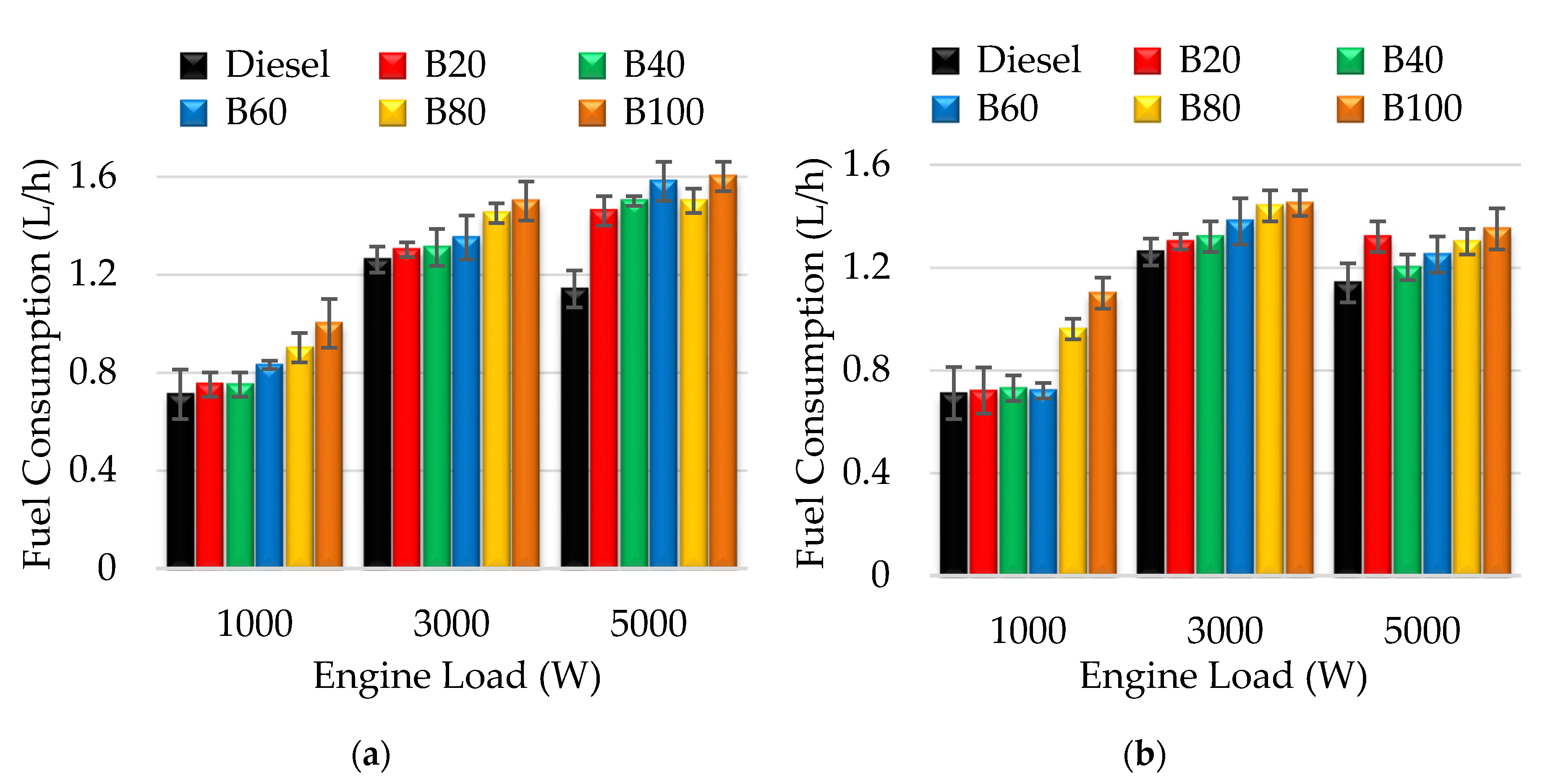
| Property | Diesel | Sunflower Oil | Castor Oil | Ethyl Acetate |
|---|---|---|---|---|
| Density at 15 °C (kg/m3) | 830.0 | 920.0 | 962.0 | 906.0 |
| Kinematic viscosity at 40 °C (cSt) | 3.20 | 37.80 | 226.20 | 0.45 |
| Oxygen content (wt. %) | 0 | 10 | 15 | 36 |
| Calorific value (MJ/L) | 35.52 | 36.43 | 38.00 | 21.55 |
| Flash point (°C) | 66.0 | 220.0 | 228.0 | −4.0 |
| Auto-ignition temperature (°C) | 250 | 316 | 448 | 460 |
| Cetane number | 51 | 37 | 40 | 10 |
| Blend | Nomenclature | B0 | B20 | B40 | B60 | B80 | B100 |
|---|---|---|---|---|---|---|---|
| % D | 100 | 80 | 60 | 40 | 20 | 0 | |
| D/EA/SO | % EA | 0 | 8 | 16 | 24 | 32 | 40 |
| % SO | 0 | 12 | 24 | 36 | 48 | 60 | |
| D/EA/CO | % EA | 0 | 9 | 18 | 27 | 36 | 45 |
| % CO | 0 | 11 | 22 | 33 | 44 | 55 |
| Model | AYERBE 4000 Diesel |
|---|---|
| Alternator | LINZ-SP 10MF 4.2 KVA |
| Engine | YANMAR LN-70 296 cc 6.7 HP |
| Speed | 3000 rpm |
| Maximum power | 5 KVA |
| Voltage | 230 V |
| Consumption | 1.3 L/H (75%) |
| Property | Blend | Ethyl Acetate (% by Volume) | |||||
|---|---|---|---|---|---|---|---|
| 0 | 20 | 40 | 45 | 50 | 100 | ||
| Kinematic viscosity (cSt) | EA/SO | 37.80 ± 0.46 | 11.52 ± 0.30 | 4.42 ± 0.04 | 3.76 ± 0.06 | 3.16 ± 0.06 | 0.45 ± 0.01 |
| EA/CO | 226.20 ± 0.55 | 26.26 ± 0.06 | 5.97 ± 0.07 | 4.47 ± 0.06 | 3.46 ± 0.12 | 0.45 ± 0.01 | |
| Diesel/Ethyl Acetate/Sunflower Oil Blend | ||||||
|---|---|---|---|---|---|---|
| Nomenclature (% Renewable) | B0 | B20 | B40 | B60 | B80 | B100 |
| 100/0/0 | 80/8/12 | 60/16/24 | 40/24/36 | 20/32/48 | 0/40/60 | |
| Cloud point (°C) | −6.0 ± 1.0 | −12.0 ± 1.0 | −13.6 ± 0.9 | −12.5 ± 0.5 | −12.2 ± 0.8 | −10.6 ± 1.0 |
| Pour point (°C) | −16.0 ± 1.2 | −19.9 ± 0.8 | −20.2 ± 1.1 | −18.5 ± 0.7 | −18.1 ± 1.0 | −19.0 ± 0.8 |
| Calorific value (MJ/L) | 35.52 | 34.51 | 33.50 | 32.49 | 31.49 | 34.38 |
| Cetane number | 51.00 | 46.04 | 41.08 | 36.12 | 31.16 | 26.20 |
| Diesel/Ethyl Acetate/Castor Oil Blend | ||||||
|---|---|---|---|---|---|---|
| Nomenclature (% Renewable) | B0 | B20 | B40 | B60 | B80 | B100 |
| 100/0/0 | 80/9/11 | 60/18/22 | 40/27/33 | 20/36/44 | 0/45/55 | |
| Cloud point (°C) | −6.0 ± 1.0 | −13.0 ± 1.0 | −15.8 ± 0.7 | −12.0 ± 0.6 | −11.0 ± 1.0 | −12.2 ± 1.0 |
| Pour point (°C) | −16.0 ± 1.2 | −21.0 ± 1.0 | −22.0 ± 1.0 | −19.4 ± 0.8 | −18.5 ± 0.6 | −20.0 ± 0.9 |
| Calorific value (MJ/L) | 35.52 | 34.54 | 33.55 | 32.57 | 31.58 | 30.60 |
| Cetane number | 51.00 | 46.10 | 41.20 | 36.30 | 31.40 | 26.50 |
© 2020 by the authors. Licensee MDPI, Basel, Switzerland. This article is an open access article distributed under the terms and conditions of the Creative Commons Attribution (CC BY) license (http://creativecommons.org/licenses/by/4.0/).
Share and Cite
Aguado-Deblas, L.; Estevez, R.; Hidalgo-Carrillo, J.; Bautista, F.M.; Luna, C.; Calero, J.; Posadillo, A.; Romero, A.A.; Luna, D. Outlook for Direct Use of Sunflower and Castor Oils as Biofuels in Compression Ignition Diesel Engines, Being Part of Diesel/Ethyl Acetate/Straight Vegetable Oil Triple Blends. Energies 2020, 13, 4836. https://doi.org/10.3390/en13184836
Aguado-Deblas L, Estevez R, Hidalgo-Carrillo J, Bautista FM, Luna C, Calero J, Posadillo A, Romero AA, Luna D. Outlook for Direct Use of Sunflower and Castor Oils as Biofuels in Compression Ignition Diesel Engines, Being Part of Diesel/Ethyl Acetate/Straight Vegetable Oil Triple Blends. Energies. 2020; 13(18):4836. https://doi.org/10.3390/en13184836
Chicago/Turabian StyleAguado-Deblas, Laura, Rafael Estevez, Jesús Hidalgo-Carrillo, Felipa M. Bautista, Carlos Luna, Juan Calero, Alejandro Posadillo, Antonio A. Romero, and Diego Luna. 2020. "Outlook for Direct Use of Sunflower and Castor Oils as Biofuels in Compression Ignition Diesel Engines, Being Part of Diesel/Ethyl Acetate/Straight Vegetable Oil Triple Blends" Energies 13, no. 18: 4836. https://doi.org/10.3390/en13184836
APA StyleAguado-Deblas, L., Estevez, R., Hidalgo-Carrillo, J., Bautista, F. M., Luna, C., Calero, J., Posadillo, A., Romero, A. A., & Luna, D. (2020). Outlook for Direct Use of Sunflower and Castor Oils as Biofuels in Compression Ignition Diesel Engines, Being Part of Diesel/Ethyl Acetate/Straight Vegetable Oil Triple Blends. Energies, 13(18), 4836. https://doi.org/10.3390/en13184836









